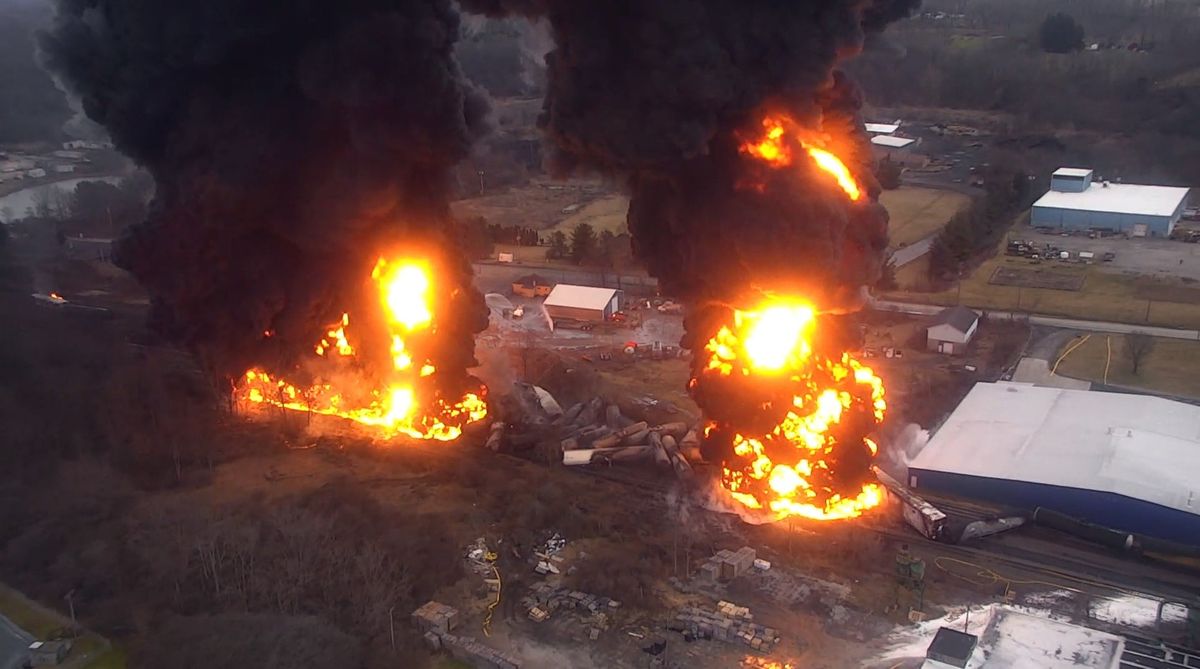Railroad operator Norfolk Southern Corp. is defending itself against a federal report finding that its decision to vent and burn the toxic chemicals in smoldering hazmat tank cars after a derailment near East Palestine, Ohio, was “unnecessary.”
The National Transportation Safety Board (NTSB) said Tuesday that the derailment occurred when a bearing on a hopper car failed and overheated, leading to the fiery, February 3, 2023, derailment in the center of the small Ohio town.
The report also found that the decision by the local incident commander three days later to conduct a “vent and burn” of the contents of the tank cars carrying vinyl chloride monomer was based on incomplete and misleading information provided by Norfolk Southern officials and contractors, and was not necessary to prevent a tank car failure, NTSB investigators said.
In addition, the original wreck became more severe in part because of Norfolk Southern’s continued use of DOT-111 tank cars to transport flammable liquids and other hazardous materials. The NTSB said that three DOT-111 cars were mechanically breached during the derailment, releasing flammable and combustible liquids that ignited. That fire led to the decision to conduct vent-and-burn action on five tank cars carrying vinyl chloride.
In response, the NTSB is calling for an accelerated phaseout of DOT-111 tank cars in hazmat service because of that model’s “unacceptable safety record.” Specifically, the DOT-111 tank car is being phased out of flammable liquids service because of its long record of inadequate mechanical and thermal crashworthiness and propensity to release lading in a derailment, the report found.
In additional safety recommendations, the report recommended changes to address:
- Failure of wayside monitoring systems to diagnose a hot wheel bearing in time for mitigation to prevent a derailment.
- Inadequate emergency response training for volunteer first responders.
- Hazardous materials placards that burned away, preventing emergency responders from immediately identifying hazards.
- A lack of accurate, timely and comprehensive information passed to local incident commanders and state officials.
In response, Atlanta-based Norfolk Southern said it had already taken action to enable the immediate availability of “train consist information” to first responders and encourage contractors to share information to make emergency response decisions. The company has also “substantially addressed” the Federal Railroad Administration (FRA) recommendations from its 2023 Safety Culture Assessment, and has since seen its mainline accident rate decline 38% last year to industry leading levels, the company said. In regard to the new findings, the railroad said, “We will move quickly to compare the NTSB's recommendations to our current protocols and will implement those that advance our safety culture.”
Likewise, rail industry group The Association of American Railroads (AAR) said it was investigating the NTSB’s new safety standards. “Among the recommendations, many of the NTSB findings align with positions the industry has long maintained, including the need to aggressively phase out DOT-111 tank cars from hazmat service and other tank car improvements. Following today’s hearing, railroads are reviewing the complete findings and recommendations to identify the potential need for additional research surrounding bearing performance or other joint industry efforts,” the AAR said in a release.
However, railroad workers union laid more responsibility at the feet of Norfolk Southern, saying, “The key point is last year’s tragic derailment wasn’t a case of error by a train crew, it was a series of errors made by railroad management.” More specifically, a key trigger of the derailment was precision scheduled railroading (PSR), an operating model that has encouraged railroads to boost profits by cutting their workforce by nearly a third over the past seven years, according to the Brotherhood of Locomotive Engineers and Trainmen (BLET). Under PSR, the largest railroads have also lengthened trains to as long as three miles from end-to-end, while reducing the number of thorough inspections of rail cars, the union said.
To correct those conditions, the union called for stricter safety regulations. “This report was about so much more than an overheated bearing,” BLET National President Eddie Hall said in an email. “Congress, federal regulators and state legislators can lessen the risk by passing long overdue rail safety reforms, including the Railway Safety Act. Further delay is not acceptable to locomotive engineers and other railroaders, and it shouldn’t be tolerated by the residents of the communities served by these railroads.”
















